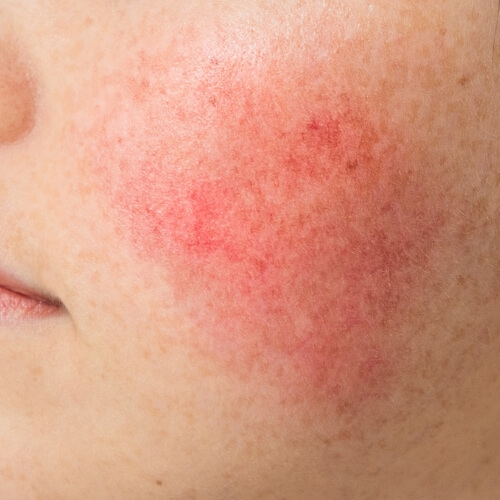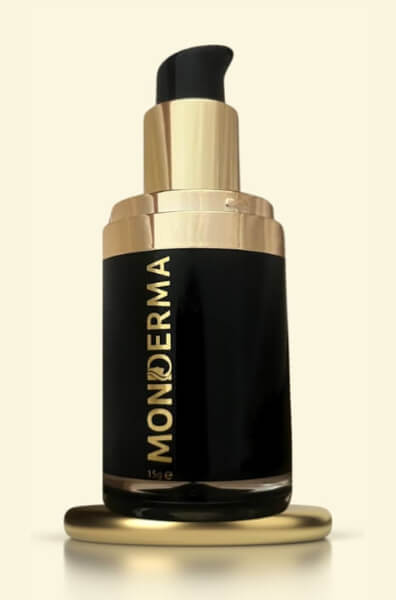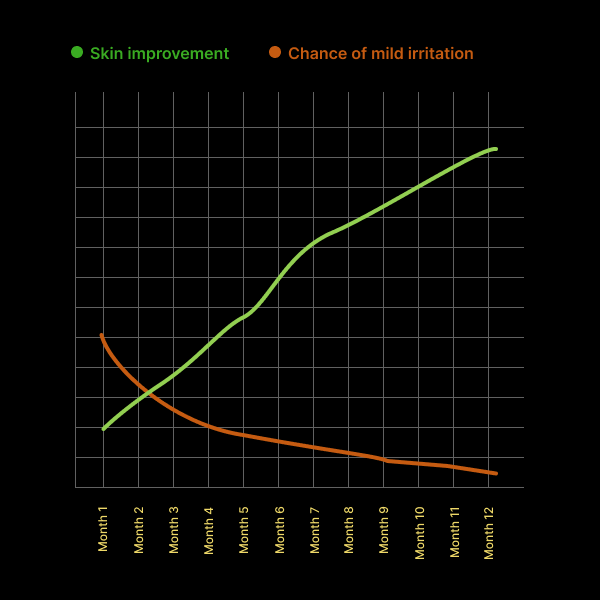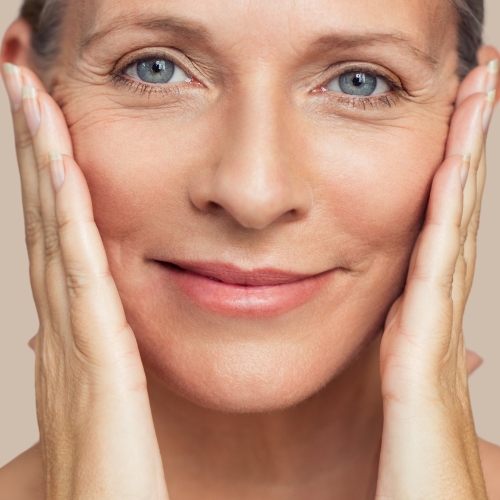
Tackling Persistent Flare-Ups?
Rosacea complicates the lives of 1 in 20 people in the UK, usually between the ages of 30 to 60, and can worsen if left untreated.
However, you can take control of it now. Manage redness, halt burning, and relieve sensitivity with Monderma’s targeted ingredients designed for your skin.
Submit
Complete a short, free skin assessment
Start
Get your custom formula every 4 weeks
Support
Track progress, and cancel, restart anytime
What Is In Your Nightly Cream?
You will find 2-3 gold standard active ingredients, excipients, and a hyaluronic acid base cream sourced from MHRA suppliers in your rosacea clearing formula.
Recyclable
Vegan Friendly
Cruelty Free
FRAGRANCE FREE
Alcohol Free
GPhC Regulated
MHRA Approved Suppliers
Dermatologist Tested
Pharmacist Led

The Monderma Difference
| Retail |  |
|---|---|
| Multiple products | All-in-one multitasker |
| Batch produced | Personalised |
| Over-the-counter | Pharmacist-led |
| Cosmetic ingredients | Active ingredients |
| Low strength | High strength |
| Rarely regulated | GPhC-regulated |
| Elementary checks | MHRA-suppliers |
| Typically imported | UK-compounded |
Transform Your Skin Today
Custom formulas are provided under the supervision of GPhC registered prescribers and pharmacists for safe, effective use.
As your treatment progresses, you will notice less redness and burning. Mild side effects such as peeling and tingling may occur but typically ease as your skin adjusts.

Tried, Tested, Loved: Hear It Firsthand
I highly recommend for mild to moderate rosacea
“I’m on azelaic acid 8%, niacinamide 4% for my fifth month and my flare-ups are barely noticeable.”
– Lauryn, C, Lancashire, UK
I noticed a difference
“I noticed a difference in my skin’s texture after 3 weeks. Feeling so much more confident now. Thank you very much!”
– Stephen, B, East Midlands, UK

Uncover your healthiest skin with personalised skincare up to 20x the strength of over-the-counter rosacea products.
Still Have Questions?
Rosacea is a chronic vascular and inflammatory, and poorly understood skin condition that affects 1 in 20 people in the UK, usually between the ages of 30 to 60.
Though it is more common in women, the symptoms are often more severe for men.
People with lighter skin tones are more likely to develop rosacea.
The symptoms of rosacea include redness, thickening, bumps, blood vessels, sensitivity, burning, and swelling.
Nearly everyone who suffers from rosacea has it on their face. The condition also affects 20% of people on the neck and chest.
Rosacea manifests in 4 subtypes:
| Subtype | Description | Common Areas |
|---|---|---|
| Erythematotelangiectatic Rosacea (ETR or vascular rosacea) | Persistent redness, visible blood vessels, a tendency to flush easily, burning, or stinging | Forehead, nose, cheeks, and chin, and in severe cases the neck or chest |
| Papulopustular Rosacea (Inflammatory or acne rosacea) | Persistent redness, bumps commonly mistaken for acne, including papules and pustules, and swelling | Around the eyes, nose, and mouth, and is less likely to spread to the neck or chest |
| Phymatous Rosacea (Glandular or rhinophyma rosacea) | Thickening and enlargement | Nose, and in severe cases the ears or chin |
| Ocular Rosacea (Rosacea keratitis) | Watery, bloodshot, burning, stinging, dry, itching, blurred, or light-sensitive vision | Eyes or the eyelids |
Up to 60% of people with rosacea experience erythematotelangiectatic, 40% papulopustular, 10% phymatous, and 30% ocular rosacea.
Rosacea is a relapsing condition that can be episodic, meaning that flare-ups can be severe for a short period of time, followed by intervals of remission.
The exact cause of rosacea is not fully understood, but several factors are believed to contribute to its development.
Flare-ups are commonly reported to be triggered by:
| Triggers | Description |
|---|---|
| Demodex Mites | Demodex mites (demodex folliculorum) are tiny parasites that live on human skin, primarily in facial hair follicles. While these mites are usually harmless and can only survive on the skin of humans, an overgrowth of them is associated with rosacea. People with rosacea frequently have higher mite densities, which can trigger an immune response, resulting in inflammation and redness. When mites die, they release bacteria that activate the immune system, causing additional inflammation and contributing to flare-ups. It is unclear whether the mites are the cause or the result of rosacea |
| Bacteria | Helicobacter pylori bacteria are linked to higher rates of rosacea in some people, possibly due to the production of bradykinin, which dilates blood vessels and may contribute to facial flushing. However, while there is a connection, helicobacter pylori is not considered a direct cause of rosacea, and treating the infection shows mixed results in symptom improvement |
| Skin Peptides | Skin peptides may have an adverse effect on the nerves, blood vessels, and the immune system. External triggers for these include very hot or cold weather, changes in wind and humidity, stress, intense exercise, certain skincare products, spicy foods, cinnamaldehyde-containing foods like tomatoes, citrus fruits, chocolate, and histamine-rich foods such as aged cheese and processed meats, as well as caffeine and alcohol, particularly red wine |
Other factors can influence the development and severity of the condition. These include:
| Contributor | Description |
|---|---|
| Genetics | Genetics may play a role in rosacea, as it tends to run in families, indicating a genetic predisposition. People with a family history of the disorder are more likely to develop it. However, it remains unclear which specific genes, if any, are involved and how they are passed down |
| Hormones | Hormonal changes, particularly those associated with birth control pills, pregnancy, and menopause can all contribute to the higher incidence of Erythematotelangiectatic Rosacea flare-ups. People with hormonal imbalances, such as those with polycystic ovary syndrome (PCOS), may experience more frequent or severe rosacea flare-ups as a result of increased androgen levels and skin sensitivity |
| Medications | Medications can trigger or worsen rosacea symptoms by increasing blood flow, causing facial flushing, or affecting the skin’s sensitivity. Blood pressure medications such as beta-blockers or calcium channel blockers, which dilate blood vessels, may cause increased redness and flushing. Corticosteroids, especially when applied to the face, can cause steroid-induced rosacea, which results in persistent redness and acne-like bumps. Furthermore, medications that affect the immune system or cause inflammation, such as niacin (vitamin B3), can exacerbate rosacea flare-ups |
Rosacea is neither contagious nor the result of poor hygiene.
There is no specific test for rosacea, so a doctor, pharmacist, or nurse can only diagnose it based on the appearance of the skin and eyes, as well as medical history. Rosacea's clinical manifestations vary in nature and severity over time, and the diagnosis is typically based solely on clinical features.
Rosacea symptoms can become increasingly worse without proper care and treatment:
| Severity | Distribution | Characteristics |
|---|---|---|
| Mild | 1-25% | Slight redness or flushing, few visible blood vessels, minor discomfort or stinging, occasional small, red bumps, and limited areas of the face affected |
| Moderate | 26-49% | Persistent redness, more visible blood vessels, frequent or more pronounced burning or stinging sensations, more numerous red bumps and pimples, welling in affected areas, and a moderate impact on daily activities and emotional wellbeing |
| Severe | >50% | Intense and persistent redness, many visible blood vessels, severe burning or stinging sensations, numerous red bumps, pimples, and possibly pustules, thickening of the skin, especially around the nose, significant swelling and possible eye involvement, major impact on daily activities, emotional wellbeing, and quality of life |
A differential diagnosis is required to rule out other conditions that present with similar symptoms and can be mistaken for rosacea. This includes:
| Condition | Description |
|---|---|
| Acne | Acne typically involves blackheads and whiteheads, which are absent in rosacea, even though rosacea can present with acne-like bumps |
| Demodicosis | Demodicosis is caused by an overgrowth of Demodex mites and can mimic rosacea symptoms, but it is often accompanied by more intense itching and a crawling sensation on the skin |
| Dermatitis | Contact Dermatitis causes redness and inflammation as a result of irritation or allergic reactions, but it is frequently associated with an external trigger such as cosmetics or skincare products. Perioral Dermatitis causes small red bumps around the mouth and chin, similar to rosacea, but does not usually cause widespread redness or visible blood vessels. Seborrhoeic Dermatitis causes redness and flaking, especially around the nose and brows, but it has a greasy appearance, as opposed to rosacea, which has dry, irritated skin |
| Keratosis Pilaris Rubra | Keratosis Pilaris Rubra causes red, rough bumps on the cheeks, arms, and thighs but lacks the blood vessel involvement seen in rosacea |
| Lupus Erythematosus | Lupus Erythematosus can produce a red butterfly rash on the cheeks and nose, similar to rosacea. Lupus, on the other hand, frequently causes systemic symptoms such as joint pain and fatigue, which rosacea does not |
Only 1 in 5 people with rosacea is aware of their condition, highlighting the need for increased awareness and diagnosis.
Rosacea cannot be cured yet, but treatment can help control the symptoms. Long-term treatment is typically required, though there may be times when symptoms improve and treatment can be discontinued temporarily.
A treatment plan can vary greatly depending on the subtype of rosacea and the individual symptoms. Rosacea can change over time, and what works at first may require adjustment.
This may contain up to 3 of the following ingredients:
| Topical | Properties |
|---|---|
| Anti-Inflammatories | Inhibit the production of inflammatory-causing molecules to reduce redness and irritation |
| Antiparasitics | Reduce the number of Demodex mites to reduce bacteria and redness |
| Antibiotics | Inhibit the production of inflammatory mediators to reduce redness and inflammation |
| Vasoconstrictors | Narrow blood vessels to reduce redness and inflammation |
| Antioxidants | Eliminate free radicals by repairing and strengthening the barrier function of the skin, improving hydration |
Treating rosacea topically must include adopting daily use of broad-spectrum sunscreen of SPF30 or higher.
It can take 8 weeks or longer to see lasting results, so it is important to be patient and follow your treatment plan. Information on these ingredients, their directions for use, safety information, storage, potential side effects, and reporting can be found in the information leafletAs Rosacea gets worse, the skin on the forehead, nose and cheeks may become constantly red. It can cause tiny, broken blood vessels to appear on the skin and remain there.
Effective management of rosacea is crucial to prevent long-term complications. This can include:
| Complication | Description |
|---|---|
| Redness | Rosacea can cause permanent skin colour changes, particularly persistent redness as a result of chronic inflammation and blood vessel dilation. Repeated episodes of flushing and inflammation lead to visible blood vessels and long-lasting redness, which can be difficult to treat without medical intervention |
| Thickening | Thickening of the skin on the nose and ears develops after years of untreated or poorly managed symptoms. This thickening causes the nose to become bulbous and enlarged, often accompanied by swollen cheeks, giving the face a distorted appearance. In advanced cases, these changes in skin texture and shape can become permanent, necessitating surgical intervention to remove excess tissue and restore the nose and facial features to a more typical appearance |
| Bumps | Small red bumps and pus-filled spots are common symptoms of rosacea and often resemble acne. However, unlike acne, rosacea does not involve blackheads or whiteheads, which are typically present in acne, making it a distinct condition despite its similar appearance |
| Blood Vessels | Blood vessels often become prominent and visible on the nose and cheeks. This happens as small vessels under the skin dilate over time, creating a web-like appearance of redness that becomes more noticeable with repeated episodes of facial flushing and inflammation |
| Sensitivity | Sensitivity is a common issue as the skin often reacts negatively to certain products or environmental factors, making it prone to irritation. This increased sensitivity can significantly limit their choice of cosmetics and makeup, as many products can exacerbate symptoms like redness and inflammation, requiring the use of specialised, gentle formulas designed for sensitive skin |
| Burning | Burning, stinging, and itching sensations are often worsened by certain skincare products or environmental triggers. In more severe cases, particularly during flare-ups, these uncomfortable sensations can worsen into pain |
| Swelling | Swelling of the face during rosacea flare-ups is frequently caused by the accumulation of fluid in the tissues, which can result in a puffy or inflamed appearance. This fluid retention typically occurs around the eyes, nose, and cheeks, intensifying other symptoms like redness and discomfort. It may persist throughout the flare-up, exacerbating the overall irritation |
| Vision | Eye symptoms that are untreated, can result in increased redness, dryness, and irritation and in severe cases, vision impairment. To avoid serious eye complications, ocular rosacea must be treated as soon as possible. Light sensitivity (photophobia), inflammation of the eyelids (blepharitis), inflammation of the conjunctiva (conjunctivitis), and, in severe cases, long-term inflammation of the cornea (keratitis) can necessitate corneal surgery |
| Psychosocial | Psychosocial effects of rosacea can be profound, leading to feelings of frustration, and diminished self-esteem. During flare-ups, people may withdraw from social situations, preferring isolation to avoid perceived judgment. The chronic and visible nature of rosacea can strain personal and professional relationships, impacting both social interactions and workplace performance |
Regular consultations with a doctor, pharmacist, or nurse are recommended to keep the symptoms of rosacea under control.




